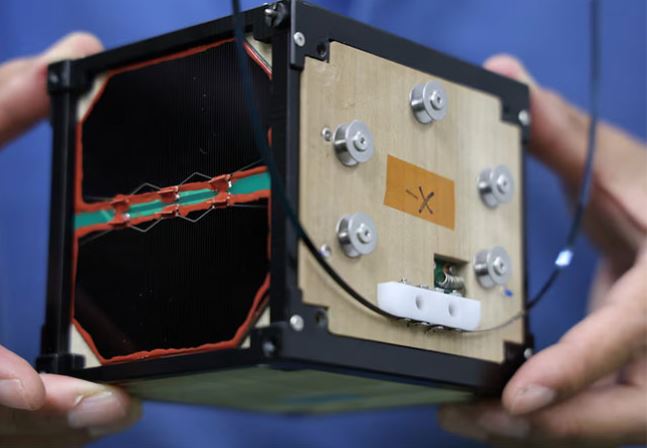

The world’s first wooden satellite, built by Japanese researchers, was launched into space on Tuesday, in an early test of using timber in lunar and Mars exploration.
LignoSat, developed by Kyoto University and homebuilder Sumitomo Forestry, will be flown to the International Space Station on a SpaceX mission, and later released into orbit about 400 km (250 miles) above the Earth.
Named after the Latin word for “woodâ€, the palm-sized LignoSat is tasked to demonstrate the cosmic potential of the renewable material as humans explore living in space.
“With timber, a material we can produce by ourselves, we will be able to build houses, live and work in space forever,†said Takao Doi, an astronaut who has flown on the Space Shuttle and studies human space activities at Kyoto University.
With a 50-year plan of planting trees and building timber houses on the moon and Mars, Doi’s team decided to develop a NASA-certified wooden satellite to prove wood is a space-grade material.
“Early 1900s airplanes were made of wood,†said Kyoto University forest science professor Koji Murata. “A wooden satellite should be feasible, too.â€
Wood is more durable in space than on Earth because there’s no water or oxygen that would rot or inflame it, Murata added.
A wooden satellite also minimises the environmental impact at the end of its life, the researchers say.
Decommissioned satellites must re-enter the atmosphere to avoid becoming space debris. Conventional metal satellites create aluminium oxide particles during re-entry, but wooden ones would just burn up with less pollution, Doi said.
“Metal satellites might be banned in the future,†Doi said. “If we can prove our first wooden satellite works, we want to pitch it to Elon Musk’s SpaceX.â€
Industrial Application
The researchers found that honoki, a kind of magnolia tree native in Japan and traditionally used for sword sheaths, is most suited for spacecraft, after a 10-month experiment aboard the International Space Station.
LignoSat is made of honoki, using a traditional Japanese crafts technique without screws or glue.
Once deployed, LignoSat will stay in the orbit for six months, with the electronic components onboard measuring how wood endures the extreme environment of space, where temperatures fluctuate from -100 to 100 degrees Celsius every 45 minutes as it orbits from darkness to sunlight.
LignoSat will also gauge wood’s ability to reduce the impact of space radiation on semiconductors, making it useful for applications such as data centre construction, said Kenji Kariya, a manager at Sumitomo Forestry Tsukuba Research Institute.
“It may seem outdated, but wood is actually cutting-edge technology as civilisation heads to the moon and Mars,†he said. “Expansion to space could invigorate the timber industry.â€
Source: Reuters
–Agencies
Nearly 30,000 Indian nationals have arrived in the country during the month of April, data…
A number of reforms including the installation of GPS and CCTV systems in buses and…
Australia’s ruling Labor Party said on Monday it would raise visa fees for international students…
The special exposition of the Sacred Tooth Relic, Siri Dalada Wandanawa, is scheduled to conclude…
The government is under pressure from the opposition to declare Sri Lanka's position in the…
Veteran singer Saman De Silva, a renowned and popular Baila artist, has passed away, family…